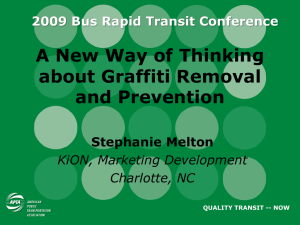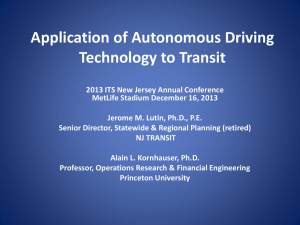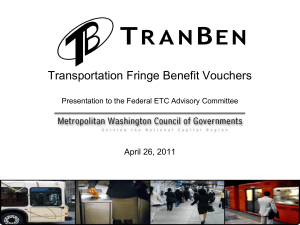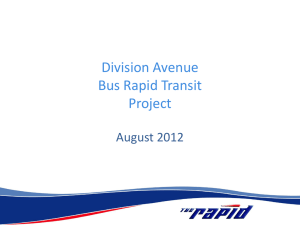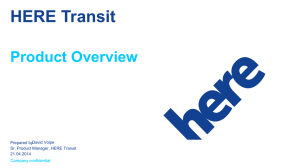TRB - Operations Research and Financial Engineering
advertisement
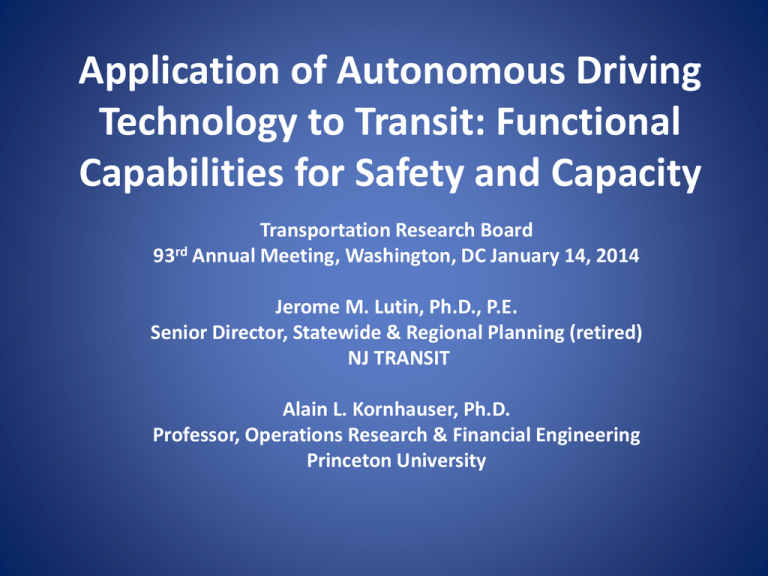
Application of Autonomous Driving Technology to Transit: Functional Capabilities for Safety and Capacity Transportation Research Board 93rd Annual Meeting, Washington, DC January 14, 2014 Jerome M. Lutin, Ph.D., P.E. Senior Director, Statewide & Regional Planning (retired) NJ TRANSIT Alain L. Kornhauser, Ph.D. Professor, Operations Research & Financial Engineering Princeton University Transit and SmartDrivingCars • Impact of Self-Driving Cars on Transit • Opportunities for Autonomous Driving Technology in Transit The Market for Transit Transit riders generally fall into two categories, captive and choice • Captive riders – cannot drive or do not have access to a car • Choice riders - generally do own cars, but choose transit when it can offer a faster, cheaper or more convenient trip. – Choice riders who own cars really appreciate the ability to while traveling on transit. “text” NHTSA Preliminary Policy on SmartDrivingCars Level 2 (Combined function automation) • Automation of at least two control functions designed to work in harmony (e.g., adaptive cruise control and lane centering) in certain driving situations. Level 3 (Limited self-driving) • Vehicle controls all safety functions under certain traffic and environmental conditions. • Driver expected to be available for occasional control. Example: Google car Level 4 (Full self-driving automation) • Vehicle controls all safety functions and monitors conditions for the entire trip. • Vehicle may operate while unoccupied. Impact of Level 2 Technology - Cars Key Features: • Jam assist; Active Collision Avoidance • Adaptive Cruise Control • Lane-Centering Likely Impacts: • Fewer crashes • Lower stress • Some increase in auto commuting trips Impact of Level 3 Technology - Cars Key Features: • Automatic Valet Parking • Limited Self-driving – freeways, pre-mapped or programmed routes, good weather Likely Impacts: • Significant reduction in center city parking time and cost • Driver can now “text” (on certain roads at certain times) • Increases in longer auto commuting trips Impact of Level 4 Technology - Cars Key Features: • Unrestricted self-driving • Autonomous Empty Vehicle Repositioning Likely Impacts: • Emergence of shared-ride AutonomousTaxi services – Non-drivers can make low-cost individual trips – Time spent in motion no longer wasted – in-vehicle experience is transformed • Vehicle trips may exceed person trips (unless rides are shared) Could This be the Future of Smart Driving Cars? Source: Airstream http://www.airstream.com/touring-coaches/interstates/photos-decor/ accessed December 30, 2013 The self-driving car as an extension of living or working space Source: Airstream http://www.airstream.com/touring-coaches/interstates/photosdecor/ accessed December 30, 2013 You could live in this. Source: Airstream http://www.airstream.com/touring-coaches/interstates/photosdecor/ accessed December 30, 2013 Impact of SmartDrivingCars on Transit • Self-driving cars will offer mobility to those transit captives who cannot drive, and, in conjunction with car-sharing, can offer mobility to those who do not have ready access to a car. • For choice riders, self-driving cars can offer amenities similar to those of transit in terms of how one can use time while traveling, to read, sleep or work. • According to studies, automated cars could double highway capacity. Couple that with the ability to self-park, and the transit advantage could melt away. • So the impact on many transit systems could be huge. Potential Applications of SmartDriving Technology to Bus Transit How can transit benefit? Source: Mercedes Benz USA https://www.youtube.com/watch?v=30a2dpHS_TU accessed December 30, 2013 Use Autonomous Collision Avoidance Technology to Address a BIG CURRENT Transit Problem Good News! Travel by Bus is getting safer! Good News! Injuries have been trending down! Terrible News! Claims are going through the roof! 2011 Nationwide Bus Casualty and Liability Expense Source FTA NTD Casualty and Liability Amount Vehiclerelated $483,076,010. Total Buses 59,871 Sub-Total Casualty and Liability Amount Per Bus $8,069/Bus/Year Casualty and Liability Claims are a Huge Drain on the Industry • For the 10 year period 2002-2011, more than $4.1 Billion was spent on casualty and liability claims • For many self-insured transit agencies these expenses are direct “out-of-pocket” • Large reserves for claims must be budgeted • Claims experience also is reflected in insurance premiums • There are gaps in data reporting Impact of Level 2 Technology - Transit Key Features: • Pedestrian and Bicycle Detection • Autonomous Emergency Braking • Lane-centering • Blind-spot Monitoring • Adaptive Cruise Control Potential Impacts: • Fewer Collisions • Fewer Injuries and Fatalities • Claims Reduction > $$ The Cost of Installing an Active Collision Avoidance System on a Bus Could be Recovered in as Little as One Year Through Reductions in Casualty and Liability Claims Impact of Level 3 Technology - Transit Key Features: • Co-operative Adaptive Cruise Control • Lane-centering • Precision docking Potential Impact: • Increased capacity in high-volume bus corridors A Capacity Bonus for NJ TRANSIT Exclusive Bus Lane (XBL) to New York City Source: Port Authority of New York and New Jersey Port Authority Bus Terminal (PABT) New York City Source: Google Maps 2013 Potential Increased Capacity of Exclusive Bus Lane (XBL) Using Cooperative Adaptive Cruise Control (CACC) (Assumes 45 toot (13.7 m) buses @ with 57 seats) Average Interval Between Buses (seconds) Average Spacing Between Buses (ft) Average Spacing Between Buses (m) Buses Per Additional Seated Increase in Hour Buses per Passengers Seated Hour Per Hour Passengers per Hour 1 6 2 3,600 2,880 205,200 164,160 2 47 14 1,800 1,080 102,600 61,560 3 109 33 1,200 480 68,400 27,360 4 150 46 900 180 51,300 10,260 5 (Base) 212 64 720 - 41,040 - Light Rail is great, but can be $$ expensive Bus Rapid Transit is much less expensive to build but has less capacity Impact of Level 4 Technology - Transit Key Features: • Bus capable of fully automated operation Potential Impact: • Paired or bus “train” operation possible • BRT systems can emulate rail in capacity at less cost Connected Vehicle and Autonomous Driving Technology for Bus Platooning – Leader/Close-Follower Concept Schematic – Wireless Short-Range Connections Between Busses Interface with Automated Driving and Passenger Systems Functions Opportunities for Autonomous Driving Technology in Transit Recommendations • Institutional Response • Technological Response Recommendation - Transit Institutional Response • Promote shared-use autonomous cars as a replacement for transit on many bus routes and for service to persons with disabilities • Demand Responsive Service (Paratransit) 2012 Avg. Cost Per Ride =$33.81, Avg. Subsidy per ride 92.4% • Exit markets where transit load factors are too low to justify operating a transit vehicle • Concentrate transit resources in corridors where more traffic and parking will be too costly and too congested, and where transit can increase the people carrying capacity of a lane beyond that of a general traffic lane Recommendation - Transit Institutional Response- Continued • Focus attention on land use – work with partners to create Transit-Oriented Development that limits the need for driving and where trip-end density will provide enough riders – – – – – Create compact activity centers Allow higher density Promote mixed use development Make streets pedestrian and bike friendly Manage parking ratios and configuration Recommendations- Transit Technological Response What do we need to do? Prepare for Technological Evolution and Obsolescence • Buses last from 12 to 18 years or more • Computer technology becomes obsolete in 18 months to two years • Expect to replace components and systems several times during the life of a bus • Do not expect replacement parts to still be available • Anticipate that sometimes stuff does not work as expected Federal Transit Administration Notice of Funding Availability • Federal Register October 1, 2013 • Seeking Research Development Demonstration & Deployment Projects – 3 Categories – Operational Safety – Resiliency – All Hazards Emergency Response & Recovery • • • • $29 million available Grants from $500k to $5 million Open to anyone Deadline December 2, 2013 Proposal Title: Application of Autonomous Collision Avoidance Technology to Transit Buses to Reduce Claims, Injuries and Fatalities Submitted by Princeton University Alain L. Kornhauser, PhD, Principal Investigator In association with: Jerome M. Lutin, PhD, LLC American Public Transportation Association Greater Cleveland Regional Transit Authority Washington State Transit Insurance Pool 1. Create a broad, inclusive stakeholder group from the transit industry to achieve a comprehensive view of the problem and potential solutions, 2. Conduct a research assessment to determine the potential for automated collision avoidance systems to reduce fatalities, injuries and claims 3. Develop functional requirements and standards to allow installation of autonomous collision avoidance technology (ACAT) and driver assist technology on new transit buses and retrofit of existing buses 4. Develop a prototype test bed that would allow developers of innovative collision avoidance and driver assist technologies to work with transit agencies and researchers to expedite development and deployment Grandpa, what’s a Drivers License? That’s something we needed in the old days before cars drove themselves. Thank You Jerry Lutin Jerome.Lutin@Verizon.net Alain Kornhauser Alaink@Princeton.edu


